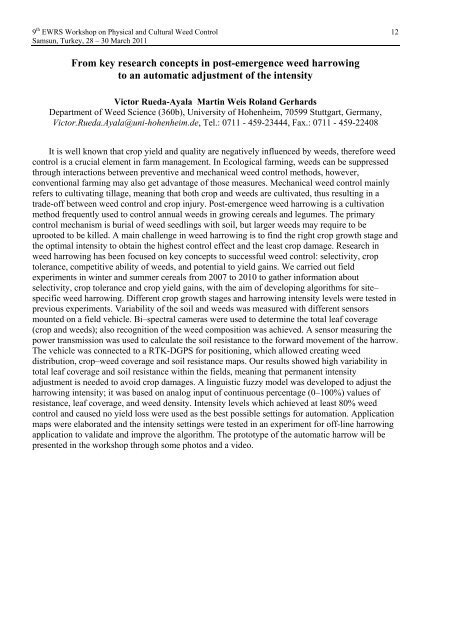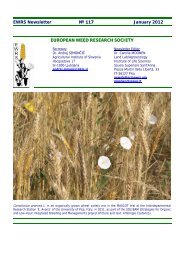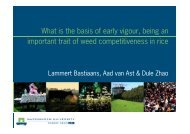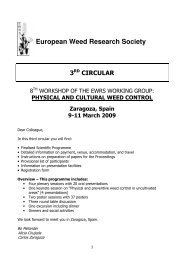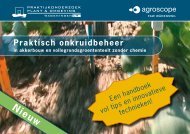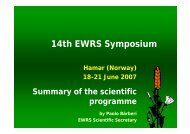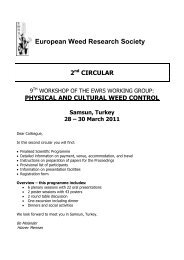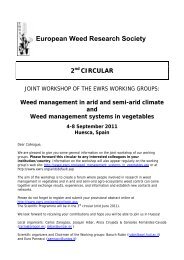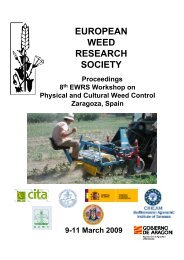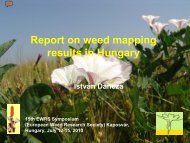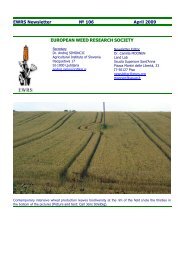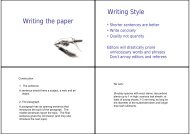Physical and Cultural Weed Control Working Group of - European ...
Physical and Cultural Weed Control Working Group of - European ...
Physical and Cultural Weed Control Working Group of - European ...
Create successful ePaper yourself
Turn your PDF publications into a flip-book with our unique Google optimized e-Paper software.
9 th EWRS Workshop on <strong>Physical</strong> <strong>and</strong> <strong>Cultural</strong> <strong>Weed</strong> <strong>Control</strong> 12<br />
Samsun, Turkey, 28 – 30 March 2011<br />
From key research concepts in post-emergence weed harrowing<br />
to an automatic adjustment <strong>of</strong> the intensity<br />
Victor Rueda-Ayala Martin Weis Rol<strong>and</strong> Gerhards<br />
Department <strong>of</strong> <strong>Weed</strong> Science (360b), University <strong>of</strong> Hohenheim, 70599 Stuttgart, Germany,<br />
Victor.Rueda.Ayala@uni-hohenheim.de, Tel.: 0711 - 459-23444, Fax.: 0711 - 459-22408<br />
It is well known that crop yield <strong>and</strong> quality are negatively influenced by weeds, therefore weed<br />
control is a crucial element in farm management. In Ecological farming, weeds can be suppressed<br />
through interactions between preventive <strong>and</strong> mechanical weed control methods, however,<br />
conventional farming may also get advantage <strong>of</strong> those measures. Mechanical weed control mainly<br />
refers to cultivating tillage, meaning that both crop <strong>and</strong> weeds are cultivated, thus resulting in a<br />
trade-<strong>of</strong>f between weed control <strong>and</strong> crop injury. Post-emergence weed harrowing is a cultivation<br />
method frequently used to control annual weeds in growing cereals <strong>and</strong> legumes. The primary<br />
control mechanism is burial <strong>of</strong> weed seedlings with soil, but larger weeds may require to be<br />
uprooted to be killed. A main challenge in weed harrowing is to find the right crop growth stage <strong>and</strong><br />
the optimal intensity to obtain the highest control effect <strong>and</strong> the least crop damage. Research in<br />
weed harrowing has been focused on key concepts to successful weed control: selectivity, crop<br />
tolerance, competitive ability <strong>of</strong> weeds, <strong>and</strong> potential to yield gains. We carried out field<br />
experiments in winter <strong>and</strong> summer cereals from 2007 to 2010 to gather information about<br />
selectivity, crop tolerance <strong>and</strong> crop yield gains, with the aim <strong>of</strong> developing algorithms for site–<br />
specific weed harrowing. Different crop growth stages <strong>and</strong> harrowing intensity levels were tested in<br />
previous experiments. Variability <strong>of</strong> the soil <strong>and</strong> weeds was measured with different sensors<br />
mounted on a field vehicle. Bi–spectral cameras were used to determine the total leaf coverage<br />
(crop <strong>and</strong> weeds); also recognition <strong>of</strong> the weed composition was achieved. A sensor measuring the<br />
power transmission was used to calculate the soil resistance to the forward movement <strong>of</strong> the harrow.<br />
The vehicle was connected to a RTK-DGPS for positioning, which allowed creating weed<br />
distribution, crop–weed coverage <strong>and</strong> soil resistance maps. Our results showed high variability in<br />
total leaf coverage <strong>and</strong> soil resistance within the fields, meaning that permanent intensity<br />
adjustment is needed to avoid crop damages. A linguistic fuzzy model was developed to adjust the<br />
harrowing intensity; it was based on analog input <strong>of</strong> continuous percentage (0–100%) values <strong>of</strong><br />
resistance, leaf coverage, <strong>and</strong> weed density. Intensity levels which achieved at least 80% weed<br />
control <strong>and</strong> caused no yield loss were used as the best possible settings for automation. Application<br />
maps were elaborated <strong>and</strong> the intensity settings were tested in an experiment for <strong>of</strong>f-line harrowing<br />
application to validate <strong>and</strong> improve the algorithm. The prototype <strong>of</strong> the automatic harrow will be<br />
presented in the workshop through some photos <strong>and</strong> a video.


